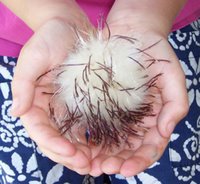
Walking around our new area we found a large powder puff. It looked like a dandelion on steroids, although it had long "sticks" of dark purple.
What could it be? The mystery begins and we were on the job!
We walked a bit farther, and saw this plant. Obviously this is a
 bloom just getting ready to erupt. The color of the inside, hiding bloom was the same as the purple sticks on String Bean's powder puff. Could this be related?
bloom just getting ready to erupt. The color of the inside, hiding bloom was the same as the purple sticks on String Bean's powder puff. Could this be related?A bit further we saw the full plant, with the bloom out of hiding.
 The prickly leaves and dryness of the ground make this plant look desolate and scary. But the flowers are so pretty! And when they bloom out, they have the same "sticks" as on String Bean's powder puff. We were getting closer to identifying the puff as a thistle. But we needed just one more piece of evidence. A walk a bit further down the road and we had the evidence we needed. A bloom had erupted and was just about to propagate it's seeds!
The prickly leaves and dryness of the ground make this plant look desolate and scary. But the flowers are so pretty! And when they bloom out, they have the same "sticks" as on String Bean's powder puff. We were getting closer to identifying the puff as a thistle. But we needed just one more piece of evidence. A walk a bit further down the road and we had the evidence we needed. A bloom had erupted and was just about to propagate it's seeds!
We'd found our plant! Searching the Internet for pictures of thistles that are native to our area, we found out that this thistle is called a Yellow Thistle -- even though it blooms purple. The Latin name is Circium Horridulum. The really interesting thing is that, under normal conditions, the thistle's powder puff (or seed propagated) would normally blow off the plant and scatter its seeds everywhere, leaving no more than a tuft of fluff here and there. Finding the whole puff, which helped us track down the plant, was like a little gift that started us on our first "nature mystery hunt".
Thanks to fellow sleuths at 4Real Forum we have found out lots about thistles -- some are edible, some are medicinal and there are some that are linked to the Blessed Mother and the Nativity! So thistles blooming in May are especially appropriate for a nature study in May, the Month of Mary!




 ...
... 



3 comments:
Well it sounds as if your first foray into nature study has been a resounding success! Thanks for this post and pictures. My children would love to find yellow thistle sometime!
Alice -- isn't it funny it's called "yellow" when it's anything but yellow? We'll have to keep our eyes on the plants and see if they yellow as they get old or something.....maybe in the fall they yellow?
Hmmmmmmmm.......
That was a wonderful nature study! Good for you!
Post a Comment